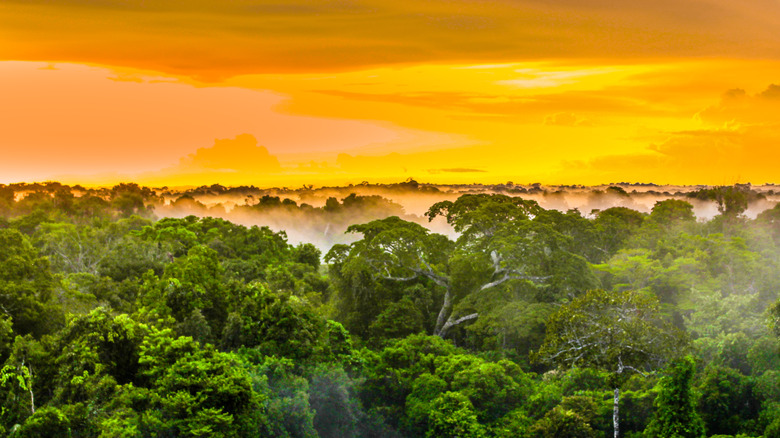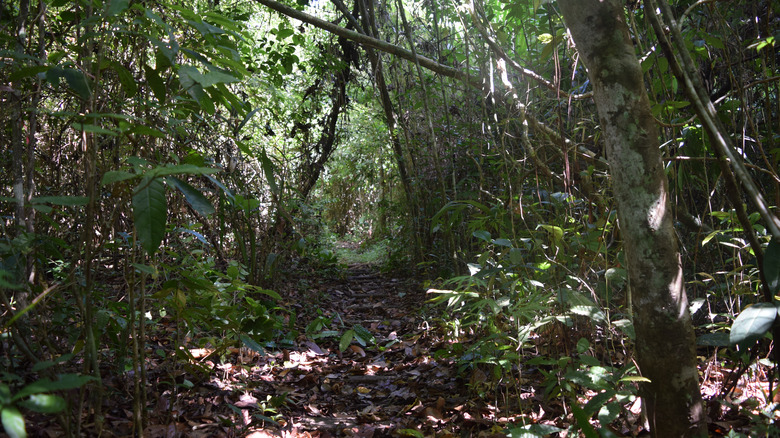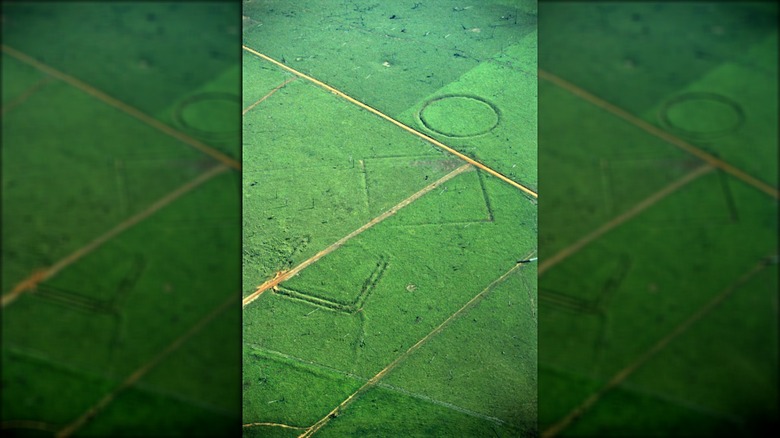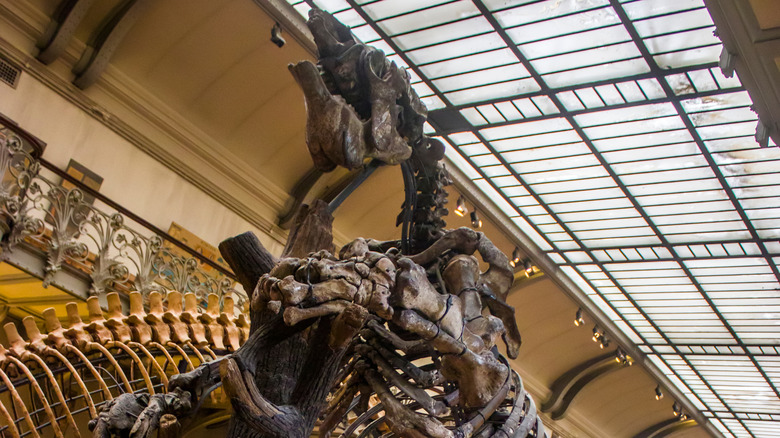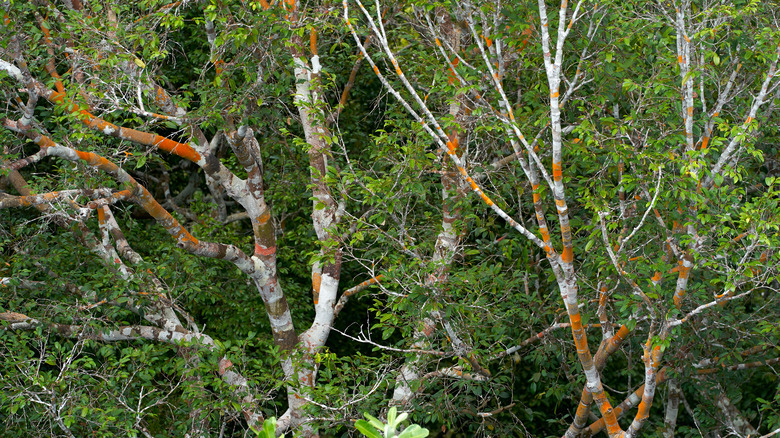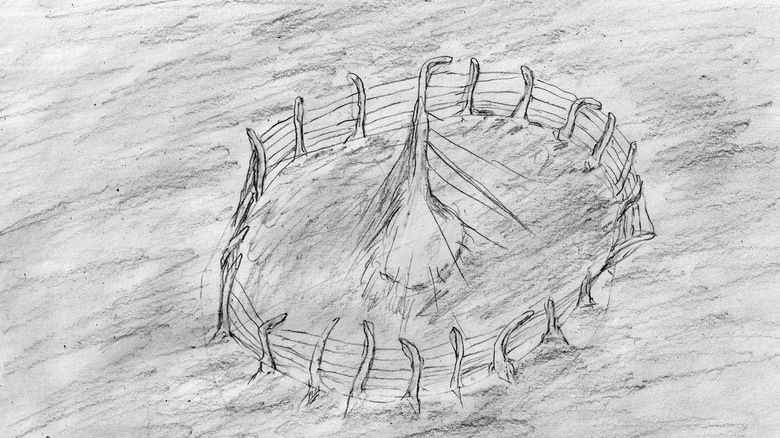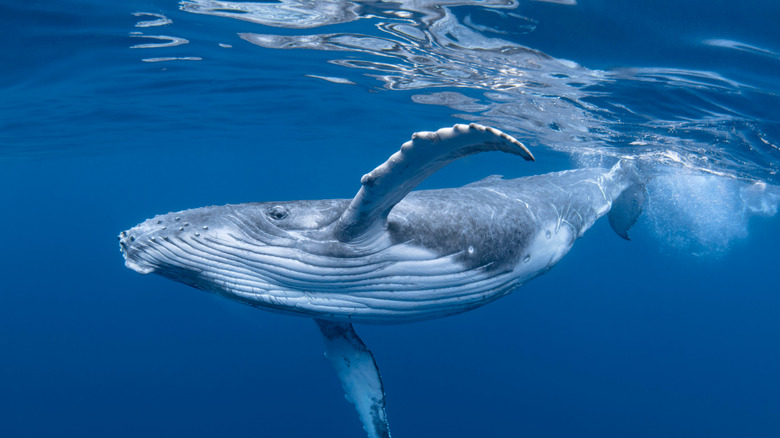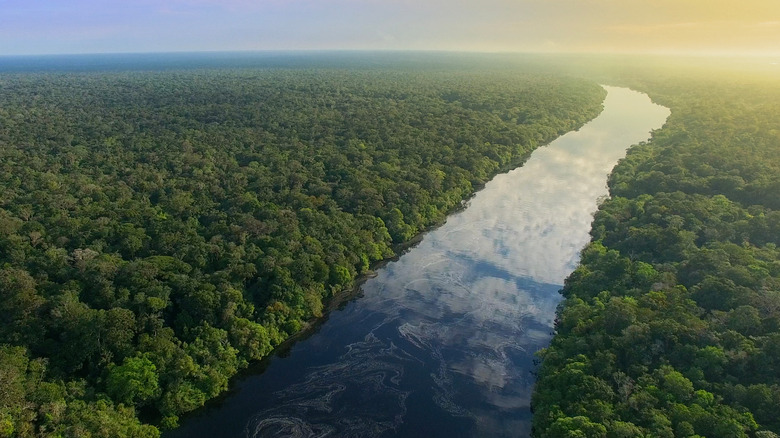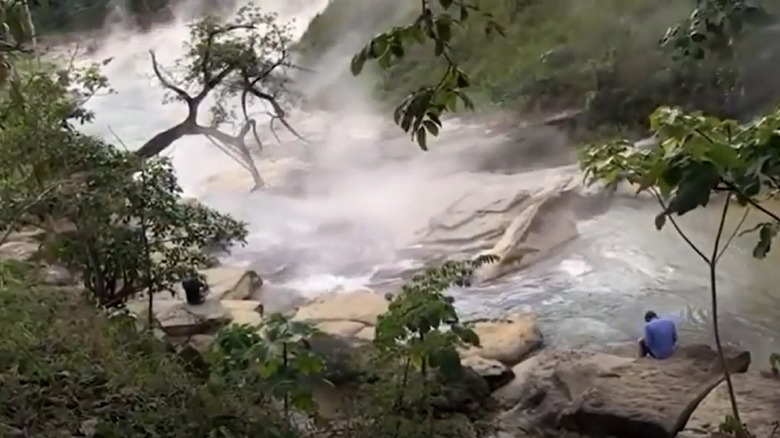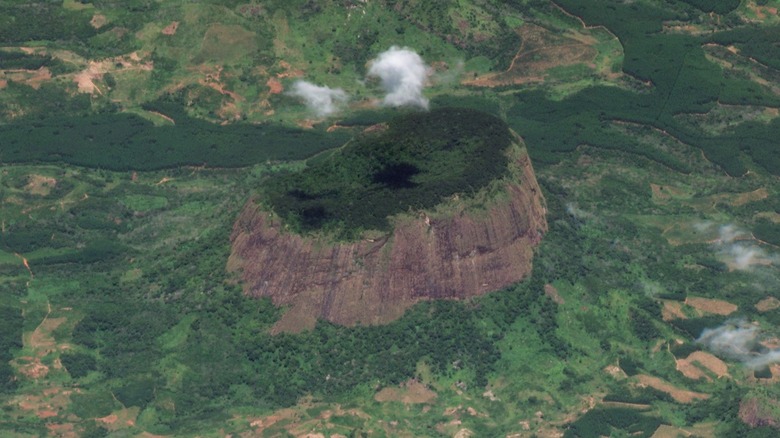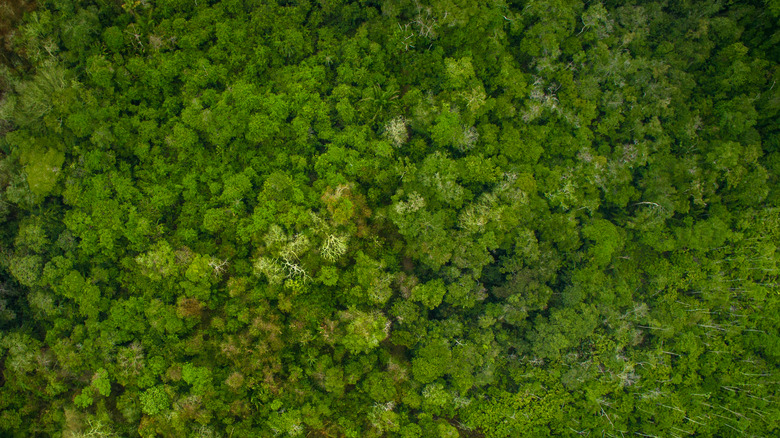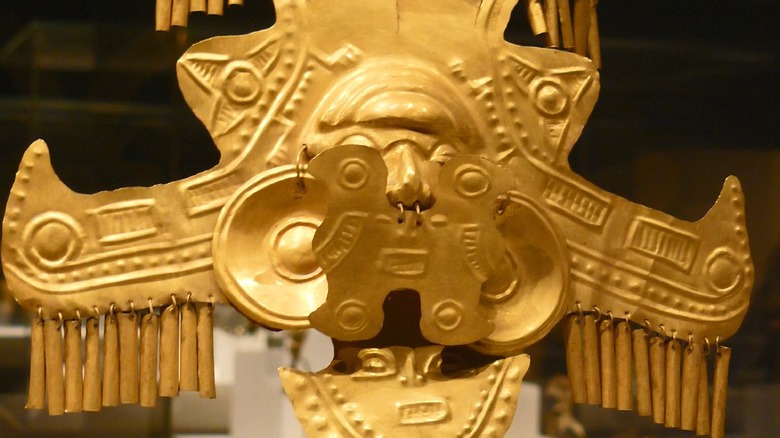Mysteries Of The Rainforest You've Never Heard Of
Rainforests around the world are full of mysteries. People have vanished in their depths, and certain species have disappeared for unknown reasons. These environments also have secrets that are only just now being discovered, such as new animal and plant species, as well as other mysterious phenomena.
Rainforests are generally perceived to have a greater abundance of animals than people, although around 400 indigenous tribes currently live in the Amazon rainforest, which spans a total of eight South American countries (via Survival International). The rainforests in the Congo Basin, meanwhile, support around 75 million Africans, writes the World Wildlife Foundation.
Historically, many people have called rainforests home, and some have left artifacts that still puzzle historians and scientists today. Similarly, plenty of perplexing natural phenomena have been discovered in the world's jungles, leaving researchers soundly stumped. These and many more little-known mysteries are what make our planet's rainforests so fascinating.
Disappearing birds on Barro Colorado Island
Panama's Barro Colorado Island is a rainforest that once had over 200 avian species. A number of them are now extinct, for reasons ecologists are investigating.
Specifically, 45 bird species have disappeared since 1914. When the Panama Canal was completed that year, Gatun Lake rose to fill in the valleys around Barro Colorado. Ecologists hypothesized in 1980 that after the larger predators died off due to lack of space, populations of mid-sized mammals like monkeys and coatis (similar to raccoons) exploded (via Oregon State University's Terra). Scientists believed the mammals were eating bird eggs.
Oregon State University ecologist Douglas Robinson began research in 1994 to solve the mystery of the disappearing birds. He made several trips to Barro Colorado to study surviving birds' flight patterns and determine what predators were poaching their eggs. He also released 10 bird species over water to see if they would fly, and if so, how far. Some easily made it to land, while others refused to move. Robinson concluded that the birds who didn't go anywhere were failing to thrive on the island, and similar species most likely went extinct for that reason.
Next, Robinson shot 10 videos to see which creatures were taking bird eggs. He expected to see mammals eating the eggs, but it turned out that snakes were the main culprit, a creature not previously considered. More evidence is needed to confirm these theories, but Robinson is continuing to research so this mystery can be solved.
Geoglyphs in the Amazon
Hundreds of large, geometrically shaped ditches have been carved into the ground of the Amazon rainforest. They are estimated to be thousands of years old, and scientists don't know why they exist. Indigenous people lived in the Amazon for many years before Europeans arrived, and they changed the landscape.
Scientists hypothesized the geoglyphs could be a ritual gathering space. "We immediately wanted to know whether the region was already forested when the geoglyphs were built, and to what extent people impacted the landscape to build these earthworks," said lead researcher Jennifer Watling (via CBC). The team didn't think the geoglyphs had a military purpose.
Watling and her team digitally reconstructed thousands of years of forest over two of the geoglyph sites. They found that indigenous tribes had been managing the forest growth by clearing the bamboo, though never for as long as today's modern deforestation, according to their research published in 2017: "Impact of pre-Columbian 'geoglyph' builders on Amazonian forests." This clearing went on for years, but on a small scale, with few adverse effects for the region as a whole.
The explorer who searched for the lost city of Z
British explorer and cartographer Percy Fawcett vanished in the Amazon in 1925. Fawcett, a World War I veteran, was also known for his mapmaking expeditions to the Amazon. He spent most of his career searching for a sophisticated and ancient city he called "Z." Fawcett attempted to set out to look for Z several times but was always set back due to illness or lack of funds. Eventually, he secured the money he needed and set out with his son Jack, as well as Jack's friend, Raleigh Rimell.
The group departed from New Jersey in January 1925, and by April, they had reached Brazil, where Fawcett intended to search. They hired native guides and traveled on through the end of May, dealing with ticks and mosquitos. On May 29, Fawcett sent the guides back to the city of Cuiabá with a packet of letters. To his wife, Fawcett wrote of their son, "Jack is well and fit and getting stronger every day." He added the following, the last thing he wrote to his wife (via History): "You need have no fear of any failure."
By 1927, Fawcett and his party had not yet returned, and it is still unclear what happened to them. Many explorers followed him, looking for his party, and several of them disappeared as well. According to History, Fawcett considered the Amazon rainforest to be "the last great blank space in the world."
Mapinguary: real or myth?
The mapinguary is a mythical sloth-like creature, and despite some tribes in the Amazon having little contact with one another, stories about this beast are ubiquitous across folklore. This creature is supposedly over 7 feet tall, hairy, and has major body odor.
There are conflicting reports from people who claim to have seen it, with the mapinguary having one or perhaps two eyes, and maybe a gaping mouth in its stomach. According to legend, if one encounters a mapinguary, it's said that the best way to kill it would be to shoot it in the head, but the most prudent course of action would be to climb a tree and make sure not to be noticed. The mapinguary is purported to be especially aggressive with those who don't treat the rainforest respectfully.
According to the New York Times, scientists have begun searching for the creature but haven't found anything yet. Ornithologist David Oren said, "It is quite clear to me that the legend of the mapinguary is based on human contact with the last of the ground sloths." He added, "We know that extinct species can survive as legends for hundreds of years."
If it does exist, scientists think that with the major deforestation of the Amazon, it would have shown itself by now. Due to fossil evidence, there is proof that Megatherium, or the giant sloth, existed during the last Ice Age, but there is no evidence to suggest that a similar creature exists today.
The fire-tailed titi monkey and other new species
Between 2014 and 2015, researchers documented over 300 new species in the Amazon rainforest. Many have luckily been discovered in protected areas. Wet tropical forests are known for having more species than other ecosystems, so it's not surprising that scientists are still finding new ones — even the rainforest can't keep all of its secrets forever.
A report from the World Wildlife Foundation includes an update on species from 2010 to 2013, in addition to new species such as the fire-tailed titi monkey from the southern Brazilian Amazon. First noted in 2010, this monkey remained unclassified through three additional expeditions and a scientific paper before it was officially declared Milton's titi monkey, which is its better-known name. The species is named after scientist Milton Thiago de Mello, whose work was instrumental in developing the field of Brazilian primatology.
With its bright orange tail, it seems as though the titi monkey would stand out, but high in the treetops, titis are hard to find. Instead, it's easier to find titi monkeys through their morning vocalizations. Fire-tailed titi monkeys do their best to keep their distance from other groups while still marking their own territory. They can be found in the protected reserves and indigenous territories of Brazil.
Silk structures in Peru
Small silk structures, about the size of a fingertip, were first discovered in 2013, and in 2019, tropical entomologist Phil Torres also captured the odd structures on video. However, scientists haven't laid eyes on the creature doing the construction, writes Live Science, though it is most likely a spider. There are all kinds of spiders out there, so which one could it be?
These "silkhenges" — named for Stonehenge because of how the central cone is surrounded by pillars — were first found in Peru. Scientists speculated that they might be protection for the egg sacs of this mysterious spider, but that has yet to be proven definitively. Researchers don't know how or why these structures are made. The hope as of 2020 was that Torres' video would help arachnologists discover what kind of silk is being spun, and thus, what kind of spider is doing the spinning.
These creations are believed to be all over the Amazon, though they mainly show up underneath broad leaves or on bark. "One key thing that we learned this time that I could say for certain is that now we're finding them in clusters. If you find one and you spend enough time looking around that immediate area, you're going to find more," Torres said. "So, that tells us something about the behavior."
Dead whale in the Amazon
A dead humpback whale was found near the edge of the Amazon rainforest in February 2019. It is unclear how the whale ended up out of the water, let alone as far as the rainforest, though scientists have their theories, writes Science Alert.
The humpback whale was estimated to be a calf (less than a year old) judging by its size, which was only 26 feet long. It was found on Marajo Island at the mouth of the Amazon River, 50 feet from shore, with no visible wounds. Humpback whales usually migrate thousands of miles to Antarctica's oceans in the summer, so the whale was in the Amazon during the completely wrong season. Humpbacks enjoy the Amazon Basin in the winter, when the salt water mixes with fresh water from the river. How could the whale calf have ended up thousands of miles from where it was meant to be?
Scientists believe the calf was separated from its mother during the migration. Humpbacks have one of the longest migrations, so it's not entirely surprising for one calf to get lost. The whale was most likely thrust onto shore by strong waves, got itself entangled in Brazilian mangroves, and couldn't get itself free again. Another theory is that the calf died by ingesting plastic waste, and its body washed ashore.
The Piripkura tribe and other isolated indigenous peoples
There are many tribes living in the Amazon rainforest who've chosen to have no contact with the outside world, even though they're aware of it. Brazil is believed to have 100 uncontacted tribes alone. Occasionally, members have ventured out into the world for reasons such as illness, though for the most part, they remain very insular.
The Piripkura people of Brazil numbered around 20 individuals in the 1980s, according to Survival International. The neighboring Gavião tribe referred to them as the "butterfly people" because of their nomadic lifestyle. In 1998, two Piripkura men left the forest to be hospitalized for an illness. During the hospital stay, they described the massacre of their tribe by hostile invaders. One surviving Piripkura woman now lives on the Karipuna people's reserve.
In April 2021, a Brazilian judge ordered FUNAI, Brazil's indigenous agency, to demarcate the roughly 600,000-acre Piripkura reserve within 90 days, writes Al Jazeera. This would finally give the Piripkura legal protection by officially assuring them of their right to the land.
The reserve — as well as the presence of Brazilian agents — will hopefully deter loggers and ranchers who want to steal indigenous tribes' land. However, with ongoing deforestation, it is likely these issues will get worse instead of better.
Boiling river
The Amazon rainforest contains a relatively unknown boiling river which supposedly kills anything that falls into it. The local town, Mayantuyacu, located in central Peru, has a shaman who considers the river sacred and uses its water for medicine.
According to Atlas Obscura, the water is anywhere from 120 to nearly 200 degrees Fahrenheit, and if someone were to fall in, they would suffer third-degree burns within seconds. The river is 4 miles long, and certain areas are up to 16 feet deep.
Geoscientist Andres Ruzo decided to study the boiling river in more depth after hearing stories about it as a child. His first expedition to central Peru was in 2011, and after receiving permission to study the river, Ruzo noted its average temperature to be 187 degrees Fahrenheit. So, it's not boiling, but it's certainly hot enough to kill small animals unlucky enough to fall in. Ruzo, however, was perplexed, as the river wasn't anywhere near any sort of volcanic activity. He hypothesized that the water sinks deep into the earth, where it heats underground before being brought back up to the surface by faults and cracks. Since his first visit, Ruzo has continued his investigation to study the river safely.
Discovery of an untouched African rainforest
Considering the sheer age of the Earth and the amount of time people have spent exploring it, it doesn't seem likely that there would be any places that have been untouched by human hands. However, there's one rainforest in Africa that has been almost completely left alone.
Dr. Julian Bayliss, a conservation scientist and butterfly expert, has spent years using Google Earth to examine African rainforests. In 2012, he discovered a rainforest within the crater on top of a mountain in Mozambique, writes BBC Earth. Five years later, he led a 28-person team to scale the mountain and explore the rainforest. Even the initial push to confirm that there was a rainforest up there was difficult; the rock face is so sheer that the drone they used to check out the forest was nearly lost.
During their trek, the scientists discovered several new species, such as a butterfly Bayliss planned to name after the mountain, which is called Lico (via The Verge). The team set up three camps, and there was constant movement back and forth for the two weeks they studied the mountain rainforest. They also discovered a few old handmade pots close to a stream, indicating the presence of humans at some time in the rainforest. The scientists hypothesized that the pots were likely an offering to ask that the river continue to flow down to people living off the mountain.
Early indigenous peoples of the South American Amazon rainforest
An 8-mile-long stretch of drawings from the last Ice Age, excavated in the Amazon in 2017 and 2018, might provide clues about the earliest humans living in the then-developing rainforest. The drawings include handprints and animals like mastodons and large sloths but also illustrations of humans and their interactions with the environment. These depictions even gave archaeologists a glimpse at what now-extinct species used to look like.
"The paintings give a vivid and exciting glimpse into the lives of these communities," said archaeologist Mark Robinson (via Live Science). "It is unbelievable to us today to think they lived among, and hunted, giant herbivores, some which were the size of a small car."
Found in the northern Colombian Amazon rainforest, the drawings are from 12,600 to 11,800 years ago, which was when the world was beginning to recover from the Ice Age. The area's rising temperatures created the rainforest as we know it today.
The LastJourney project, whose researchers helped excavate the caves where the drawings were found, is continuing research to figure out when people first settled the Amazon and how they affected its biodiversity. South America was the last continent to be colonized by humans, which began around the time of the last Ice Age (via LastJourney). The discovered drawings are certainly a step in the right direction in continuing to solve this mystery.
The mythic city of El Dorado
European explorers believed in the lost city of El Dorado for hundreds of years, thinking there was a rich civilization hidden away in the South American rainforest. But did it really exist?
According to recent archeological evidence (via the BBC), El Dorado did not exist quite the way they had imagined it to be. The traditions of the Colombian Muisca tribe may offer an explanation for this mythical city. For the Muisca tribe, "the golden one" was originally a very rich ruler, not a civilization. New rulers needed to go through a rite of passage, which required a long period of initiation. Afterward, the new ruler was brought to the center of a lake to make his offerings to the gods. Gold was thrown into the lake, since for the Muisca, gold was connected to the divine. It did not signify wealth but instead meant balance and peace.
Europeans were drawn to Colombia because of rumors of this treasure — and of the mythical city of El Dorado which supposedly held the gold. Centuries later, looters continue to exploit Colombia for its gold. After further discoveries of gold in the 1970s, the gold market was flooded and even crashed. Much of that discovered gold has been melted down, taking the knowledge of ancient Colombia with it.
